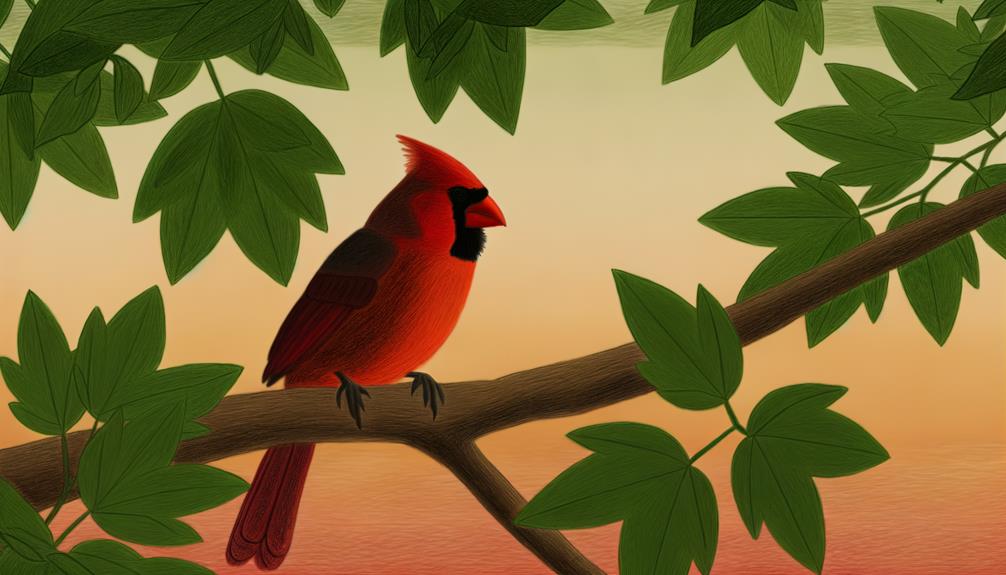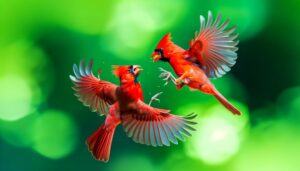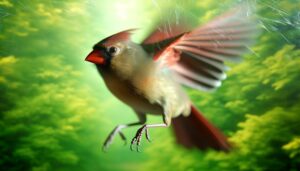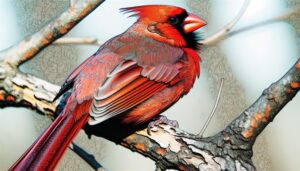Understanding How Long Do Male Cardinals Live
Male cardinals generally have a wild lifespan of around three years, with their first year being particularly risky. However, with adequate protection and resources, they can live up to 15 years in ideal conditions.
Predation by hawks, owls, and domestic cats significantly impacts their longevity, as do environmental stresses like habitat loss and climate change. Their diet—rich in seeds, fruits, and insects—plays a vital role in their health and survival.
In captivity, male cardinals can exceed 20 years due to reduced threats and controlled diets. Learning about their specific behaviors and conservation efforts can offer further insights.

Key Takeaways
- Wild male cardinals live an average of 3 years, with higher mortality in the first year.
- Under ideal conditions, wild male cardinals can reach up to 15 years.
- Captive male cardinals often live longer, sometimes exceeding 20 years.
- Predation, environmental stress, and food scarcity significantly affect wild cardinal lifespans.
- Conservation efforts include habitat preservation and addressing threats like pesticides and invasive species.
Average Lifespan
When examining the average lifespan of male cardinals, it's important to take into account factors such as predation, habitat, and diet. Typically, male cardinals in the wild live around three years. However, under ideal conditions, they can reach up to 15 years.
You should consider that survival rates can be notably lower during their first year due to higher vulnerability. Once they survive past this critical period, the chances of reaching an older age increase.
Captive male cardinals, free from natural threats, tend to live longer, sometimes exceeding 20 years. Understanding their lifespan requires observing these variables closely, as they directly influence the birds' longevity. This approach ensures a thorough grasp of their life expectancy in varying environments.
Factors Affecting Longevity
When you examine the factors affecting the longevity of male cardinals, you'll find that predators and survival rates play an important role. Environmental stressors, such as habitat destruction and climate change, also greatly impact their lifespan.
Understanding these variables helps you appreciate the challenges these birds face in the wild.
Predators and Survival Rates
Despite their vibrant plumage, male cardinals face numerous threats from predators such as hawks, owls, and domestic cats, which greatly impact their survival rates and overall longevity. In the wild, these avian and mammalian predators have keen hunting abilities that make cardinals particularly vulnerable.
Hawks and owls use their sharp vision and swift flight to catch cardinals mid-air, while domestic cats often stalk them from the ground. Predation pressure is most intense during the breeding season when males are more conspicuous. Studies indicate that predation accounts for a significant portion of adult cardinal mortality.
As a result, understanding predator-prey dynamics is essential for developing conservation strategies aimed at improving the survival rates of male cardinals in their natural habitats.
Environmental Stress Factors
Male cardinals' longevity isn't only influenced by predation but also significantly affected by various environmental stress factors. These include habitat loss, climate change, and food scarcity. Each of these elements plays a critical role in their survival.
Habitat loss reduces the availability of nesting sites and protective cover. Urbanization and deforestation eliminate nesting and feeding sites.
Climate change can disrupt migration patterns and breeding cycles. Altered seasonal behaviors impact breeding and food availability.
Food scarcity leads to malnutrition and weaker immune systems. Limited access to seeds and insects results in poor nutrition.
Understanding these factors helps you appreciate the delicate balance required for male cardinals to thrive.
Role of Diet
A cardinal's diet influences its lifespan, with a diverse intake of seeds, fruits, and insects providing important nutrients for maintaining optimal health and longevity.
Seeds, particularly sunflower and safflower, offer high-energy content and essential fatty acids. Fruits like dogwood berries supply vitamins and antioxidants, which bolster the immune system and combat oxidative stress. Additionally, insects are a vital protein source, aiding in muscle maintenance and feather health.
By ensuring a balanced diet, you can help cardinals optimize their metabolic functions and enhance their resilience against diseases.
When you observe a cardinal foraging, note the variety in its diet—this diversity is key to understanding how diet directly impacts its overall well-being and life expectancy.
Impact of Predators
Predators play a significant role in determining the lifespan of male cardinals, as these birds must constantly evade threats from various animals, including hawks, owls, and domestic cats.
Each predator employs unique hunting strategies that increase the risk to cardinals:
- Hawks: Utilizing their keen eyesight, hawks can spot male cardinals from great distances, making them formidable aerial hunters.
- Owls: As nocturnal predators, owls take advantage of the night to ambush unsuspecting cardinals, catching them off guard.
- Domestic cats: These agile hunters pose a significant threat in urban and suburban areas, often stalking cardinals at feeders or nests.
Understanding these predation patterns helps explain the survival challenges faced by male cardinals, contributing to their overall lifespan variability.
Environmental Conditions
In addition to predation, environmental conditions significantly influence the lifespan of male cardinals by affecting their access to food, shelter, and suitable breeding sites. If you look at regions with harsh winters or prolonged droughts, you'll see that these conditions can reduce the availability of seeds and insects, their primary food sources.
Without adequate nutrition, male cardinals face increased mortality rates. Additionally, habitat destruction, such as deforestation, limits their nesting options, making them more susceptible to predators and harsh weather. Urbanization also fragments their living spaces, disrupting their natural behaviors and breeding success.
Thus, understanding how environmental factors shape their survival is essential for conservation efforts aimed at ensuring their longevity and population stability.
Genetic Influences
You'll find that genetic influences play a pivotal role in determining the lifespan of male cardinals. Specific genes can affect longevity by regulating metabolic processes and resistance to diseases.
Additionally, hereditary health factors inherited from parent birds greatly impact their overall life expectancy.
Lifespan Determining Genes
Genetic influences play a crucial role in determining the lifespan of male cardinals. Specific genes affect their longevity and overall health. By understanding these genetic factors, you can appreciate how intricate the life expectancy of these birds truly is.
Key genes impact:
- Metabolism: Genes regulate how efficiently energy is used, influencing overall strength.
- Immune response: Genetic coding determines the strength and resilience of their immune system.
- Cellular repair mechanisms: Specific genes control the ability of cells to repair damage, directly correlating to aging and life span.
These genetic components interact intricately, shaping the biological framework that dictates how long a male cardinal might live.
When you consider these genetic aspects, you gain a deeper insight into the biological underpinnings of their longevity.
Hereditary Health Factors
Hereditary health factors greatly influence the lifespan of male cardinals by dictating their susceptibility to various diseases and physiological conditions. Genetic predispositions can make them more prone to ailments like avian pox and feather mites, both of which can severely impact their health.
You'll find that certain genes govern their immune response efficiency, affecting how well they fend off infections. Additionally, inherited metabolic rates play a role in their energy management and overall well-being. Mutations in DNA repair genes can lead to increased oxidative damage, accelerating aging.
Understanding these genetic influences allows you to grasp why some male cardinals live longer than others, despite facing similar environmental challenges. Therefore, the genetic blueprint is crucial in determining their longevity.
Seasonal Behaviors
During the winter months, male cardinals often exhibit increased territorial aggression to secure resources. This behavior is essential for their survival as food becomes scarce. You'll notice them fiercely defending feeding grounds, which guarantees they and their mates have enough to eat.
Key behaviors include:
- Aggressive chases: You'll see males rapidly pursuing intruders to expel them from their territory.
- Vocalizations: Expect louder, more frequent calls to assert dominance over the area.
- Physical displays: Males often fluff their feathers and engage in confrontational posturing.
These actions are vital for maintaining their territory and access to food. Understanding these seasonal behaviors provides insight into their survival strategies and overall life expectancy.
Common Health Issues
Many male cardinals face common health issues that can greatly impact their longevity and quality of life. You'll find that parasites like mites and lice are frequent problems, often leading to feather loss and skin irritation.
Bacterial infections, particularly from contaminated food or water sources, can result in severe illness.
Respiratory diseases, such as avian pox and mycoplasmosis, impair breathing and energy levels. Additionally, exposure to pesticides and other toxins can cause organ damage or neurological disorders.
Predation stress from cats and larger birds also contributes to a weakened immune system.
Lifespan in Captivity
In captivity, male cardinals often live much longer than their wild counterparts due to controlled environments that minimize predators and provide consistent access to food and medical care.
You'll find that several factors significantly contribute to their extended lifespan:
- Controlled diet: A balanced and nutrient-rich diet tailored to their specific needs.
- Medical care: Regular veterinary check-ups and prompt treatment of illnesses.
- Safe habitats: Protection from natural predators and harsh weather conditions.
These conditions ensure that captive male cardinals can reach ages of 13 to 15 years, far surpassing the average lifespan in the wild.
Lifespan in the Wild
Wild male cardinals typically live between 3 to 5 years, facing numerous challenges like predation, disease, and environmental hazards that greatly impact their longevity. Predators such as hawks, cats, and snakes pose constant threats. Disease, particularly avian pox and West Nile virus, further reduces their lifespan. Environmental hazards include harsh weather conditions and habitat destruction, which can lead to food scarcity.
You must also consider intraspecies competition for resources and mates, which adds stress and impacts survival rates. Understanding these factors highlights the delicate balance cardinals maintain in their natural habitat. While some males can surpass the average lifespan, reaching up to 15 years, such instances are rare and influenced by favorable conditions and genetic resilience.
Conservation Efforts
You should focus on habitat preservation strategies and threat mitigation measures to guarantee male cardinals live longer.
Maintaining native vegetation and controlling invasive species are pivotal actions for preserving their natural habitats.
Additionally, addressing threats like pesticide use and predation can greatly enhance their survival rates.
Habitat Preservation Strategies
Effective habitat preservation strategies hinge on a deep understanding of the ecological needs and behaviors of male cardinals. You should focus on creating environments that support their survival and reproduction.
Here are key strategies:
- Native vegetation: Preserve and plant indigenous shrubs and trees that provide food and nesting sites.
- Water sources: Guarantee the availability of clean water sources like birdbaths or natural ponds.
- Minimize disturbances: Reduce human activities and pet access in cardinal habitats to lessen stress and predation risks.
Threat Mitigation Measures
Addressing the primary threats to male cardinals involves implementing targeted conservation efforts that focus on reducing habitat loss, predation, and environmental pollutants. You should consider habitat restoration projects, which aim to reestablish native vegetation and create safe nesting sites. Predation can be minimized by installing predator guards and fostering community awareness about pet control. Reducing environmental pollutants necessitates advocating for stricter regulations on pesticide use and promoting organic farming practices.
| Threat | Mitigation Measure |
|---|---|
| Habitat Loss | Habitat restoration and native vegetation |
| Predation | Predator guards and pet control awareness |
| Environmental Pollutants | Stricter pesticide regulations and organic farming |
| Climate Change | Supporting policies for carbon reduction |
Conclusion
To sum up, male cardinals' lifespans, like delicate clockwork, pivot on various factors. Diet, predators, and environmental conditions intricately intertwine, impacting their longevity.
While they can live longer in captivity due to controlled settings, wild cardinals face numerous challenges. Conservation efforts remain essential to secure their survival.
By understanding these dynamics, you can appreciate the intricate interplay that governs their lives, nurturing a deeper respect for these colorful birds and their natural habitats.






